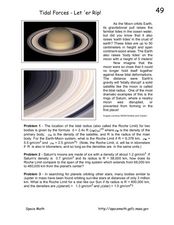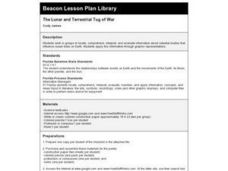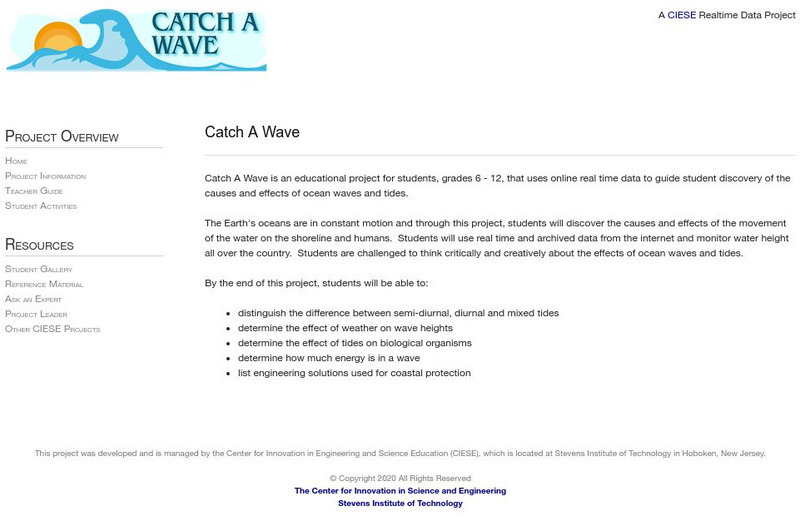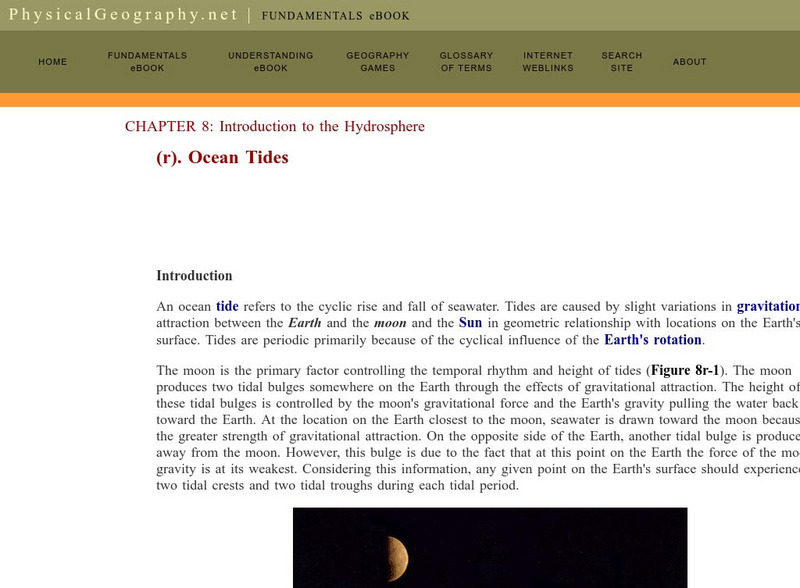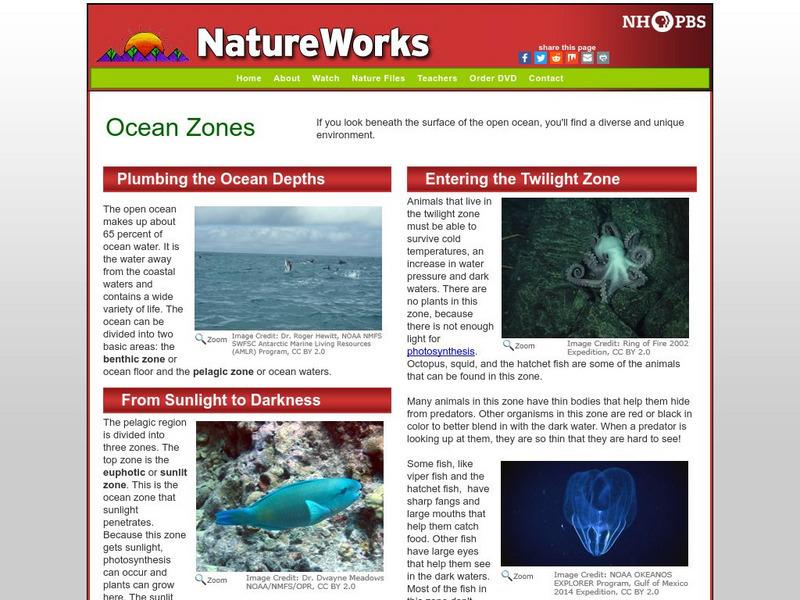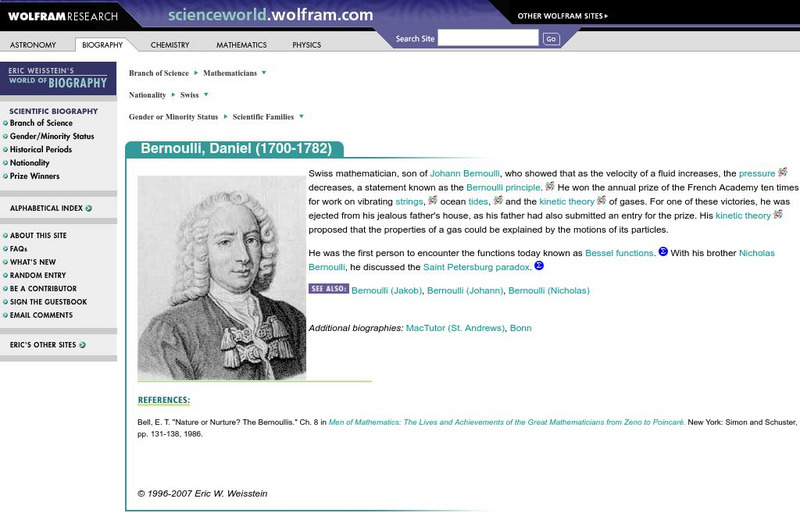Curated OER
Tidal Forces-Let'er Rip!
In this tidal forces worksheet, students read about the gravitational pull from the moon that causes the ocean tides. Students solve 3 problems including finding the Roche or the tidal radius for the Earth and Moon, comparing the Roche...
Curated OER
Tides & Lunar Cycles
Students demonstrate how the moon affects the tides, a neap tide, and spring tides by using their bodies as models. After students observe the model they created, they draw and label the diagram on a provided worksheet. They then log...
Curated OER
Jeopardy 8th Grade (Science)
There are so many topics touched upon in this Jeopardy-style science game, that it is difficult to classify! The categories include electricity, matter, ecology, earth and space, and scientific investigation. This would best be used at...
Curated OER
Why is There a Tidal Bulge Opposite the Moon?
Students simulate how the Moon causes ocean tides. In this earth science lesson, students calculate gravitational acceleration using a mathematical formula. They compare the force of attraction between the Earth, Moon and Sun system.
Curated OER
Ocean Tides
In this ocean tides worksheet, students read 2 pages about ocean tides and answer true or false questions about it. Students complete 10 questions.
Curated OER
Spring Tides
In this tides worksheet, students read about spring tides. Then students use a source of tide information to determine the high and low tides for the day and the phase of the moon. Students draw an illustration of the alignment of the...
Curated OER
The Lunar and Terrestrial Tug of War
Fourth graders, in groups, locate, comprehend, interpret, and evaluate information about celestial bodies that influence ocean tides on Earth. They apply this information through graphic representations.
NOAA
Noaa: Our Restless Tides
This site provides an excellent explanation of the nature of tides and how they are formed. The one shortcoming is the use of the fictional "centrifugal force", but this is commonly misused in literature.
Center for Innovation in Engineering and Science Education, Stevens Institute of Technology
Ciese: Catch a Wave
In this project for Grades 6 to 12, students will use real data collected online to learn how waves and tides work. They will learn what causes water to move, and how waves and tides impact on humans, organisms and waterfront lands. They...
Other
Physical geography.net: Introduction to the Hydrosphere: Ocean Tides
This is the last (18th) section of a textbook chapter on the hydrosphere. It explains what causes tides and tidal variations, describes some different types of tides, and shows on a world map where these tides occur. Includes link to a...
Woods Hole Oceanographic Institution
Whoi: What Causes Tides?
The Woods Hole Oceanographic Institute provides an in-depth but easy to read article on the role of the moon and the sun in respect to tides.
Other
Rutgers Marine & Coastal Sciences: Cool Classroom
Students and teachers can explore the work of marine scientists and observe the ocean from their computers. Learn about Rutgers Coastal Ocean Observation Laboratory, discover why oceanography is important, and see what life is like in...
San Diego State University
San Diego State University: Researching Research
This comprehensive unit site from the San Diego State University is geared towards seventh grade math and science students. "Students will chose a research project currently in progress and research it using traditional techniques, the...
Other
Moon Tides: How the Moon Affects Ocean Tides
Discusses the different kinds of tides, high and low tides, lunar tide facts, questions people have asked about tides, and causes of tides.
PBS
Nh Pbs: Nature Works: Ocean Zones
Discover more about the underocean environment at this site that surveys animals, environmental factors such as light and temperature, currents, animals, plants, and the like.
NASA
Science at Nasa: Ocean Tides Lost and Found
This article explains what forces are at work on changing the tides of our oceans.
NOAA
Noaa: National Data Buoy Center: What Are Tides?
This site from the National Data Buoy Center presents a brief description of the nature of ocean tides.
Wolfram Research
Wolfram Science World: Daniel Bernoulli
This site from ScienceWorld provides a brief biography of Daniel Bernoulli's major scientific accomplishments, including Bernoulli's principle, vibrating strings, ocean tides, and the kinetic theory of gases. Links are included to...
Trinity College Dublin
Trinity College: Daniel Bernoulli
Part of a biography web page including information on James, John, and Daniel Bernoulli. The site includes information originally published in "A Short Account of the History of Mathematics" by W. W. Rouse Ball (4th Edition, 1908).


